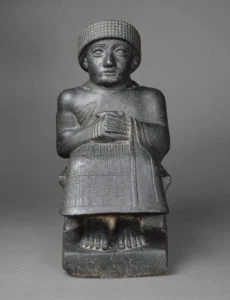A SHORT HISTORY OF PORTRAIT PAINTING
Painting has been portrayed for as long as there has been painting. Portrait paintings were believed to have originated in ancient Egypt, where artworks reach back at least 5,000 years (although many other ancient peoples also practiced portrait artistry).
Portraits are defined by the Tate Modern museum
as simply a “representation
of a specific person”. Paintings are not the only way artists can
create portraits. Sculptures, photos and drawings are also considered portraits
as long as the art aims to depict the expression, likeness or mood of a
particular person.
2144-2124 BC
STATUE OF GUDEA - THE
MET MUSEUM
Some of the earliest known portraits are called
the “Statues of Gudea”.
28 of these little statues remain and are considered portraiture because they
all have similar features which appear to be representative of and unique to
Gudea - a powerful ruler of ancient Lagash.
55-79 AD
Ancient portrait murals from Pompeii have been
well-preserved for almost 2000 years by lava and ashes. One of the most famous
is titled “Terentius Neo and his wife”. He holds a scroll and her a tablet -
originally thought to be indicative of their status andeducation. Historians of
today now disagree on Terentius Neo’s profession, some claiming him as a law
student while others believe he was a baker (http://www.portrait-masters.com/history/).
985 AD
During the renaissance and middle ages, portrait
artistry began to take on a new form. Rather than highly realistic features of
their subjects, artists of this time tended to create portraits with
stereotypical facial expressions, flat backgrounds, and a lack of realism (portrait-masters.com).
1503 AD
In 1503 AD, Leonardo da Vinci created perhaps
the most iconic portrait of modern art history: the Mona Lisa. Da Vinci used a
different technique than many other painters of this time. Instead of hard and
very realistic lines, da Vinci used soft and blended brush strokes. While the
Mona Lisa is an incredible painting with her playful smirk and expressive eyes,
this painting probably got most of its notability due to its infamous theft in
1911. During this era, only the wealthy, powerful, and those with status could
afford a portrait painting. Paints and canvas were hard to come by, and had to
be made by apprentices in a studio.
Mid to Late 1800s
VINCENT VAN GOGH
SELF-PORTRAIT 1887
With the Industrial Revolution came mass
production of art supplies. This meant that for the first time, middle class
families could afford to purchase supplies and learn to paint. Notable French
painters such as Gustave Courbet and Honoré Daumier were part of the Social
Realism movement, and for the first time depicted portraits of the middle and
working classes at the time. This is also the time when the Impressionists and
Post Impressionists began questioning the nature of portrait artistry, and
pushing their artistic boundaries.
Perhaps the two most revolutionary artists of
this period were Vincent Van Gogh and Paul Gauguin. Both created portraits in
the late 1800’s that were shockingly different than any portraits that had been
created up until this time (craftsy.com).
Early 1900s
During this time, artists began exploring the
inner psyche of their sitter, more so than their facial features or
expressions. Portraiture emerged as an exploration into human psychology, with
artists such as Matisse and Picasso playing with color, line, and form like
never before.
PABLO PICASSO PORTRAIT
OF DORA MAAR 1937
1960s
ANDY WARHOL MARILYN
MONROE 1962
In the mid-1900s, portrait artistry began to
become less popular - instead making way for abstract and conceptual arts. In
the 1960s, however, artists such as Andy Warhol and Roy Lichtenstein brought
portraits back to the limelight with the introduction of pop-art.
Today
Perhaps the form of
portrait artistry that is most widely practiced today is the art of the selfie.
With our cell phones, we have all become expert portrait artists, snapping
photos of those we love and ourselves in a variety of places and situations. In
the art world, portrait artistry and portrait paintings continue to be a
popular art form that can take many, many different approaches and forms.
Credit-ARTIST CHRISTINA CARMEL








No comments:
Post a Comment
Your Comments